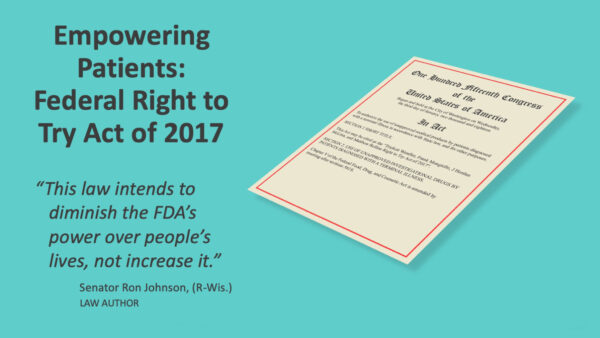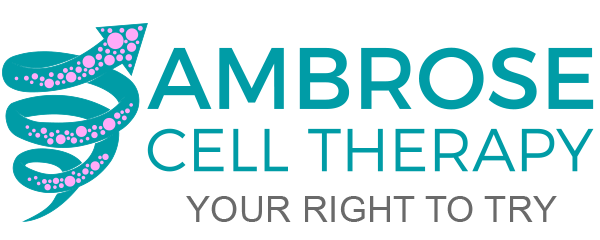Our “Right to Try”
On May 30, 2018, President Trump signed an enlightened humanitarian bill, the Trickett Wendler, Frank Mongiello, Jordan McLinn, and Matthew Bellina Right to Try Act of 2017 (Right to Try Act, the ACT or RTT), into law.[1] More on that in a moment; first, some history that led to the passage of the bill:

Our rights to health and life have been recognized internationally for many years:
- In the 1946 Constitution of the World Health Organization (WHO), stated, “…the enjoyment of the highest attainable standard of health is one of the fundamental rights of every human being without distinction of race, religion, political belief, economic or social condition.”
- Just two years later, the right to life and health was addressed in the United Nations’ Universal Declaration of Human Rights: “Everyone has the right to life, liberty, and security of person.” (Article 3) and further, “Everyone has the right to a standard of living adequate for the health and well-being of himself and of his family including food, clothing, housing, and medical care…” (Article 25)
- Many other similar declarations, including the 1966 International Covenant on Economic, Social, and Cultural Rights, also recognized our right to health.
The Right to Try Act was the culmination of a national campaign led by the Goldwater Institute. As a public policy think tank, the Goldwater Institute has been the impetus behind 40 passing Right to Try laws.
Patient Opportunities
The purpose of the Right to Try Act is to empower patients who are terminally ill or have life-threatening diseases to take control of their health by having the right and opportunity to seek treatment that is not approved by the FDA. Through the passage of this Act, patients who have a life-threatening disease, or condition, do not qualify for clinical trials and have exhausted all treatment options, as determined by their physician, can receive experimental drugs and therapies to treat their conditions. However, patients must access these treatments through a certified physician as a way to protect the patient.
Life Threatening and Debilitating Conditions
As referenced in the Act[2], the FDA’s scope of life threatening diseases includes both life-threatening and severely debilitating conditions. Life threatening means diseases or conditions where the likelihood of death is high unless the course of the disease is interrupted, and diseases or conditions with potentially fatal outcomes, where the endpoint of clinical trial analysis is survival. The criterion for life-threatening does not require the disease to be immediately life-threatening or to result in death immediately.
“Severely debilitating” is defined as diseases or conditions that cause major irreversible morbidity (the condition of being diseased).[3] Overall, the Right to Try Act has given new hope to patients with these conditions who believed they were out of treatment options.
Empowering Patients – Diminishing FDA
The FDA recognizes that their role in these cases is limited by the Right to Try Act, and that drug companies, sponsors, and manufacturers can determine the effectiveness and safety of experimental drugs.
After the bill was signed into law, Dr. Scott Gottlieb, then Commissioner of the FDA, stated, “Our implementation of the Right to Try Act will build on our long-standing efforts to help patients and families who are facing life-threatening diseases or conditions, in a way that seeks to protect their autonomy, their safety, and the safety of others following in their paths.”[4]
In response to Dr. Gottlieb, Senator Johnson wrote a letter to the Commissioner. He emphasized the intention of the Right to Try Act is to empower patients: “As I made clear to my colleagues in the Senate and the House before each body voted on §, 204, this legislation is fundamentally about empowering patients to make decisions in cooperation with their doctors and the developers of potentially life-saving therapies. This law intends to diminish the FDA’s power over people’s lives, not increase it. It is designed to work within existing FDA regulations, definitions, and approval processes. It is not meant to grant FDA more power or enable the FDA to write new guidance, rules, or regulations that would limit the ability of an individual facing a life-threatening disease from accessing treatments. Under this law, the FDA’s oversight with respect to patient safety within a Phase 1 trial remains unchanged; the current thresholds for successful completion of such a trial phase remains unchanged.” [5][6]
Subsequently, the FDA acknowledged the law and now provides this advice to patients: “If you are interested in Right to Try, you should discuss this pathway with your licensed physician.” Further, in an email to FDA staff, Janet Woodcock, the director of the agency’s Center for Drug Evaluation and Research, told staff to direct any inquiries about the new law to drug companies.
Celution® Cell Processing System
AMBROSE accesses the mixed population of stem and regenerative cells in a patient’s fat (adipose tissue) using the Celution system. This cell preparation is called adipose-derived stem and regenerative cells (ADRCs). ADRCs processed with the Celution® System meet the criteria in the Act. Celution-processed ADRCs have been approved for use 9 in FDA phase 1/2 safety trials.
Additional Celution bonafides include but are not limited to:
- Japan Ministry of Health, Labor, and Welfare (MHLW) Class 3 Device Approval
- Japanese researchers and clinicians, including leading academic hospitals such as the University of Tokyo and Nagoya University, report treating over 4,000 patients with a range of chronic conditions with Celution-processed ADRCs.[7]
- CE-Mark Approval in over 40 countries internationally.
- Researchers have published over 90 Celution System Studies or Case Reports covering a wide range of chronic diseases.[8]
- In the 12 years since Celution was approved in Europe and Japan, there has not been a single report of a cell-related adverse event.
In summary, our Right to Try is fundamental to our health and well-being. Ambrose Cell Therapy provides ADRC-based treatments under the Right to Try Act in alignment with our Mission: To help people with chronic degenerative diseases improve symptoms, function, and quality of life using adult stem cell therapy.
[1] The ‘‘Trickett Wendler, Frank Mongiello, Jordan McLinn, and Matthew Bellina Right to Try Act
of 2017.” Retrieved from the United States Congress official website.
[2] CFR 21 Chapter 1 § 312.81 Scope
[3] Code of Federal Regulations 21CFR312.81
[4] Statement from FDA Commissioner Scott Gottlieb, M.D., on the signing of the Right to Try Act. Retrieved from the FDA Official Newsroom.
[5] Official letter from Senator Ron Johnson to Dr. Scott Gottlieb on May 31, 2018. Full document here.
[6] “‘Right-to-try’ law intended to weaken the FDA, measure’s sponsor says in blunt remarks.” Article retrieved from Stat News.
[7] Cytori-Japan Investor Presentation August 2023
[8] JK Fraser PhD and S. Kesten MD Autologous Adipose Derived Regenerative Cells: A platform for therapeutic applications Advanced Wound Healing Surgical Technology International XXIX
